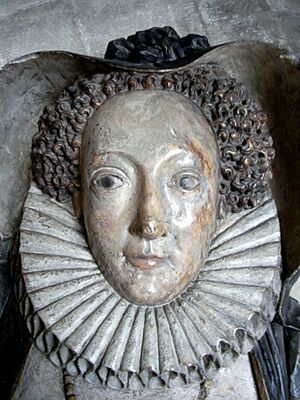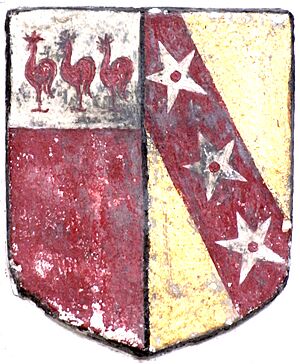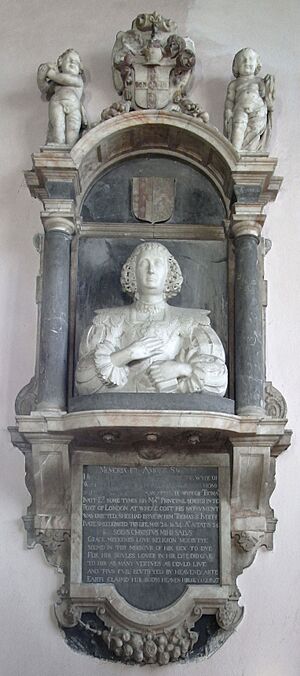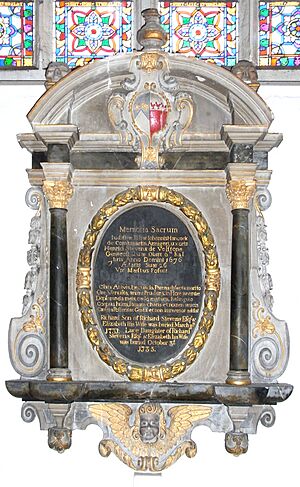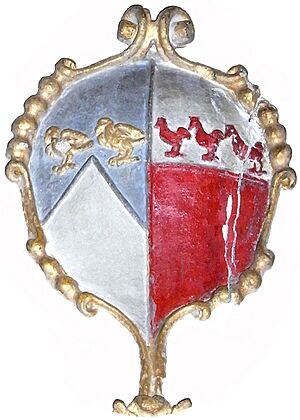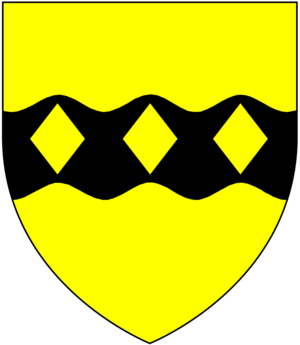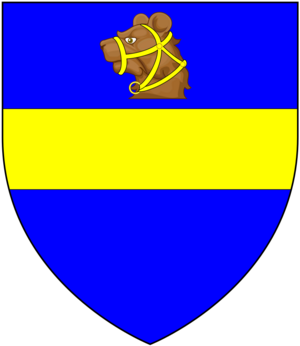Mount Radford, Exeter facts for kids
Mount Radford was a historic estate, or large property, located in the area of St Leonards, right next to the east side of the city of Exeter in Devon, England.
Contents
Who Owned Mount Radford?
The Radford Family
- Lawrence Radford built the first Mount Radford House. This was during the time of Queen Elizabeth I (1558-1603).
- A historian named Sir William Pole (who died in 1635) wrote about it. He said Lawrence Radford built "a fair house" on a small hill and named it Mount Radford.
- Lawrence's son, Arthur Radford, later sold the property. He sold it to Edward Hancock.
The Hancock Family
Edward Hancock (c.1560-1603)
Edward Hancock bought Mount Radford from the Radford family. He was a Member of Parliament (MP) for several towns. An MP is a person elected to represent a group of people in the national parliament. He studied law and became a lawyer.
Edward married Dorothy Bampfield. Her father was Sir Amyas Bampfylde, also an MP. Edward Hancock died in 1603. His son, William, was only one year old.
Dorothy later married Sir John Doddridge. He was an important judge. Dorothy had a beautiful monument built for her in Exeter Cathedral.
William Hancock (1602-1625)
William Hancock was very young when his father died. His mother, Dorothy, remarried Sir John Doddridge. Sir John helped care for William.
William married Judith Newman when he was 23. They had two children:
- Anne Hancock, who married a church leader named Rev. George Cary.
- John Hancock, who was born the same year William died.
William died in 1625, leaving Judith a young widow.
Judith later married Thomas Ivatt. He was a royal official in the Port of London. Thomas built a monument for Judith in Combe Martin church. It has a statue of her and a poem.
John Hancock (1625-1661)
John Hancock was William's son. He was only one year old when his father died. He married Mary Sainthill. They had three children:
- Edward Hancock
- John Hancock
- Judith Hancock (1650-1676). She married Henry Stevens. Her monument is in Great Torrington Church.
The Duck Family
- Nicholas Duck (1570–1628) bought Mount Radford in 1614. He was a lawyer and served as the Recorder of Exeter. This meant he was the city's chief legal officer. He was also an MP for Exeter.
- His father, Richard Duck, built "Duck's Almshouses" in Heavitree. These were homes for poor people and still exist today.
- Richard Duck (1603–1656) was Nicholas's eldest son. During the English Civil War, Mount Radford House was used by the Royalists. They fortified it to defend Exeter.
- Nicholas II Duck (1630–1667) was Richard's eldest son. He married his cousin, Martha Duck. She was the daughter of the very wealthy Sir Arthur Duck, who was also a lawyer and writer.
- Richard II Duck (1657–1695) was Nicholas II's eldest son. He married Elizabeth Acland in Exeter Cathedral. Her family, the Aclands, were important landowners in Devon.
The Colesworthy Family
John Colesworthy owned Mount Radford in 1755. He faced financial problems and sold the house. He sold it with 17 acres of land to John Baring for 2,000 guineas.
The Baring Family
The Baring family bought Mount Radford next. They were important local merchants and bankers. They even started a famous international bank called Baring Brothers.
- John Baring (1730–1816) was a merchant and banker. He bought Mount Radford in 1755. He also bought other nearby lands.
- He rebuilt the old 16th-century house in a new, grand Georgian style. He added a long driveway lined with cedar trees. This driveway is now St Leonards Road.
- In 1816, John Baring had money problems. He sold Mount Radford to his cousin, Sir Thomas Baring, 2nd Baronet.
- Sir Thomas Baring then sold the property to a builder in 1826.
Mount Radford School
In 1826, Mount Radford House became a school. It was known as "The Exeter Public School" or "Mount Radford College." The school closed in 1902.
A different school with the same name opened nearby later. A famous student from that school was the comedian Tommy Cooper.
Sale of Land
In 1832, a plant expert named James Veitch bought 25 acres of land from the estate.
What Happened to Mount Radford?
In 1902, the house was torn down. The land was then used to build new homes. This area is now part of the eastern suburbs of Exeter. Today, you can find Barnardo Road and Cedars Road there.



